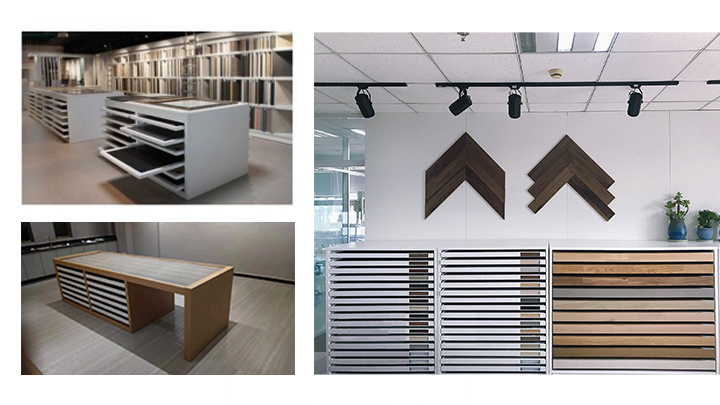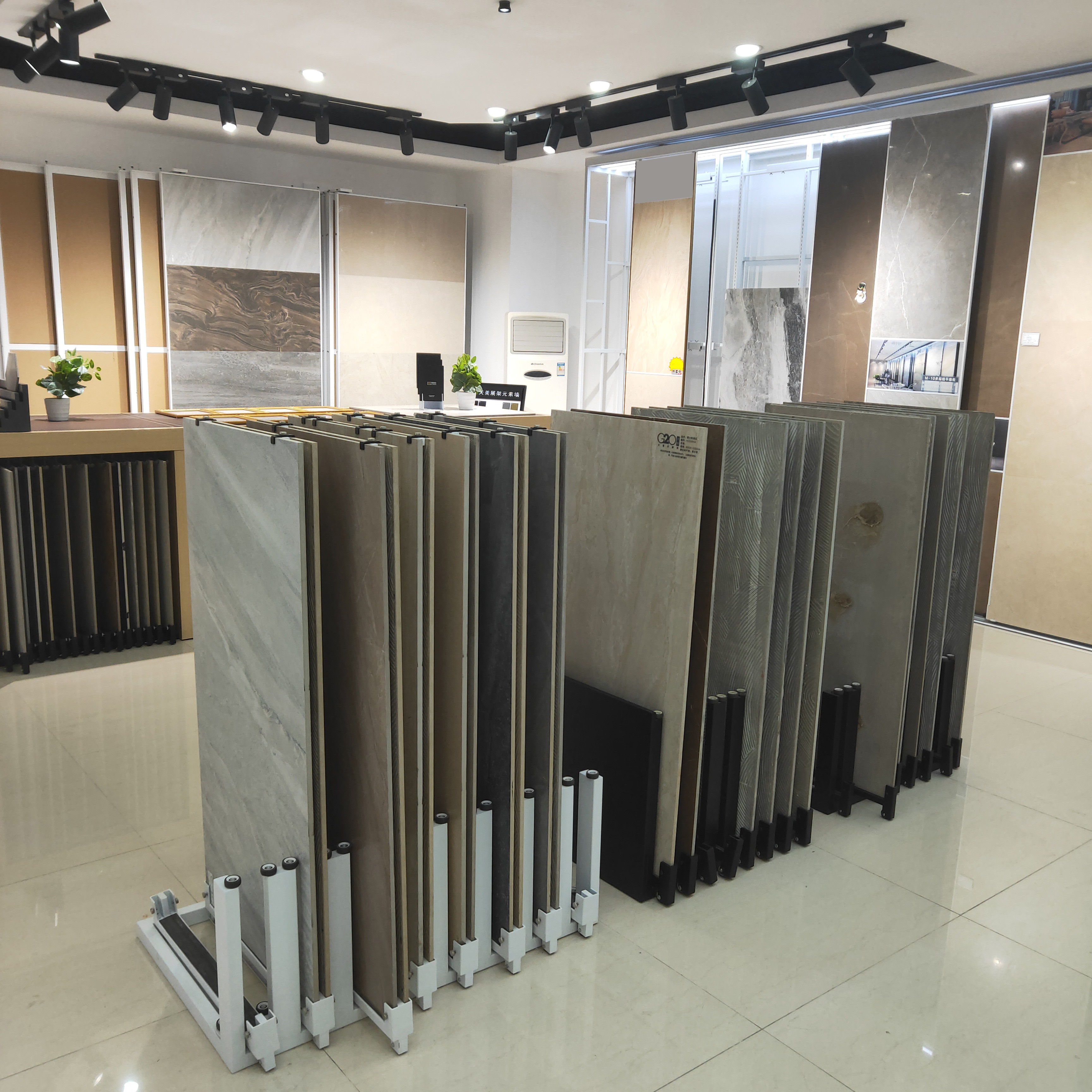In the competitive world of tile retail, effective visual merchandising through well-designed product displays can be a game-changer. According to a study published in the Journal of Marketing, organized and visually appealing displays have the potential to boost sales by a staggering 540% compared to disorganized or lackluster displays.
For tile retailers, strategically arranged tile sample displays play a crucial role in shaping the customer experience and influencing purchase decisions. By showcasing products in an attractive and inspiring manner, retailers can capture attention, highlight unique features, and create a desire for their tile offerings. According to industry reports, CPG merchandising executives have reported a perceived increase in sales of 19% from permanent displays and temporary displays alike.

Why Tile Sample Displays Matter
Tiles are a high-consideration purchase that requires careful deliberation from customers. Unlike many other products, the texture, color, and overall aesthetic of tiles can vary significantly from digital representations or small samples. As such, providing tile samples is crucial for customers to make an informed and confident decision that will stand the test of time.
Effective tile displays allow customers to not only see and feel the tiles in person, but also visualize how they will look when installed. By arranging tiles in a thoughtful and inspiring manner, retailers can help customers envision the end result and envision the tiles in their desired space. This hands-on experience is invaluable, as ordering samples empowers customers to make decisions they will be satisfied with for years to come.
Floor Standing Tile Displays
Floor standing tile displays offer a versatile and eye-catching way to showcase your tile collections. These freestanding units come in various styles to suit different needs and spaces.
Waterfall Displays: These cascading racks create a striking visual effect with tiles arranged in a staggered, flowing pattern. Waterfall displays are ideal for highlighting a range of tile sizes and textures, allowing customers to easily view and compare options. However, they can be more challenging to access individual tiles. Source: How to Arrange Ceramic Tile Display Racks?
Spinning Racks: Rotating tile racks offer a compact footprint while maximizing display capacity. Customers can spin the rack to view all sides of the tile samples conveniently. These units are highly space-efficient but may require more effort to browse specific tiles.
Diagonal Step Racks: With a stepped, angled design, these racks create a dynamic, eye-catching display. Tiles are arranged diagonally, making it easy for customers to view multiple options simultaneously. Step racks offer enhanced stability and durability, with “welded seams reinforcing structural integrity.” Source: Iron Floor Tile Display Rack, 5 Layer, 35x150cm, Black …

Wall-Mounted Tile Displays
Wall-mounted tile displays offer an excellent space-saving solution for showcasing tile samples in showrooms. One popular option is slatwall racks, which feature horizontal slats for hanging tile samples or shelves. According to ExeDisplays.com, “Wall mounted tile display[s] display tiles on the wall, [providing] a great way to maximize space in your showroom.”
Picture frame displays are another wall-mounted option, allowing you to swap out tile samples easily. These displays can be arranged in a grid pattern or staggered for visual interest. The key advantage of wall displays is their ability to maximize vertical space, making them ideal for smaller showrooms or areas with limited floor space.
When arranging wall displays, group tiles by color, style, or intended use for a cohesive look. Proper lighting is crucial, so position displays near natural light sources or install track lighting to highlight the tile textures and colors. Consider incorporating shelving or plinths beneath wall displays to showcase complementary accessories or grout samples.
Portable and Flexible Displays
For tile retailers with limited floor space or frequently changing inventory, portable and flexible display options provide versatility. Mosaic Display offers flip-type mosaic display stands and combined mosaic display stands that can be easily reconfigured.
Sample boards and tile plinths are lightweight yet sturdy solutions for showcasing individual tiles or small groupings. Portable cases with handles allow sales staff to transport tile samples for off-site presentations or design consultations.
The ability to rotate stock and feature new arrivals is key. Flexible displays enable retailers to keep their showroom fresh and highlight seasonal trends or promotional items. Investing in a mix of portable and permanent fixtures ensures an ever-changing, engaging shopping experience.
Factors for Choosing Tile Displays
When selecting tile displays stand for your showroom, several key factors should be considered to ensure they effectively showcase your products and enhance the customer experience. Firstly, the material and construction quality are crucial, as displays need to be durable and able to withstand the weight of numerous tile samples. Look for sturdy materials like metal or high-quality wood that can support heavy loads without sagging or wobbling.
Adjustability is another essential feature, as it allows you to accommodate different tile sizes and shapes. Opt for displays with adjustable shelves, racks, or compartments, enabling you to create custom configurations that best highlight your tile offerings. This flexibility also makes it easier to update or rearrange displays as your product range evolves.
The capacity and footprint of the displays should align with your showroom’s space and inventory. Consider the number of tile samples you need to exhibit and choose displays with sufficient capacity to avoid overcrowding. At the same time, ensure the displays have a compact footprint that optimizes floor space and allows for comfortable customer navigation.
Portability and mobility are valuable qualities, especially if you plan to participate in trade shows or events. Look for displays with casters or wheels that allow for easy relocation within the showroom or transportation to off-site venues. This versatility can also be beneficial when rearranging or updating your showroom layout.
Finally, visual appeal is a critical factor in creating an inviting and engaging environment. Select displays that complement your showroom’s aesthetic and branding, with sleek designs, attractive finishes, and optional features like integrated lighting or signage holders. Visually appealing displays can elevate the overall shopping experience and help your tile samples stand out.

Arranging Tiles for Maximum Impact
Strategically arranging tile samples can significantly enhance their visual appeal and draw customers’ attention. A well-organized display not only showcases the products effectively but also facilitates the shopping experience. Consider the following tips:
Group by Product Type: Categorize tiles based on their intended use, such as floor tiles, wall tiles, outdoor tiles, or decorative tiles. This logical grouping helps customers quickly identify the options relevant to their needs. Additionally, you can subdivide each category by material (ceramic, porcelain, natural stone, etc.) or style (modern, rustic, patterned, etc.).
Color Coordination: Harmonize the color schemes of adjacent tile samples to create a visually cohesive and appealing display. Coordinate complementary hues or arrange tiles in a gradient, transitioning from light to dark shades. This approach not only enhances the aesthetic appeal but also allows customers to visualize how different tiles might work together in their space.
Highlight New Arrivals: Dedicate a prominent section of your display to showcase the latest tile collections or trending designs. Use eye-catching signage or lighting to draw attention to these areas, enticing customers to explore the newest offerings.
Effective Lighting: Proper lighting is crucial for showcasing the true colors, textures, and patterns of tile samples. Use a combination of ambient and directed lighting to eliminate shadows and highlight the intricate details of each tile. Consider installing adjustable lighting fixtures or spotlights to create a dynamic and visually appealing display.
Clean and Organized Displays: Maintain a tidy and well-organized display area, free from clutter or distractions. Regularly dust and clean the tiles to ensure they look their best. Straighten and rearrange samples as needed to maintain an orderly appearance. A clean and organized display conveys professionalism and makes it easier for customers to navigate and appreciate the products.
Supporting Customer Inspiration
Beyond simply displaying tile samples, retailers can create immersive and inspiring experiences to guide customers. Lifestyle vignettes, which showcase tiles in realistic room settings like bathrooms or kitchens, allow shoppers to envision the finished look. Displaying photos of installed tile projects can further spark ideas and demonstrate potential layouts or patterns. Offering complimentary design services and advice elevates the customer experience, helping bring their visions to life. Ultimately, these techniques forge an emotional connection between the customer and the product, making them more likely to purchase.
As Quantum Group NI advises, “Create displays based on different themes, such as modern, rustic, or bold and colourful, to inspire customers. Use tiles that fit the theme along with complementary accessories like furniture and decor items.”
Common Display Mistakes to Avoid
One of the biggest pitfalls in tile merchandising is a cluttered, disorganized display. When samples are haphazardly arranged, it creates a chaotic and uninviting shopping experience. As Linda Cahan advises in her article on retail visual design, “Displaying art with merchandise often requires an easel. Those $12.50 easels that are raw wood are a realllllly bad idea for a display of any merchandise over $50.” Outdated or damaged tile samples should be promptly removed and replaced to maintain a fresh, appealing showroom.
Inconsistent branding and signage can also detract from an otherwise thoughtful display. Whether through mismatched hangtags, conflicting fonts, or clashing color schemes, mixed messaging prevents customers from connecting with your brand identity. Proper lighting is essential for showcasing tile textures, patterns, and colors accurately. Dim or uneven lighting obscures product details and creates an uninviting atmosphere.
Finally, lack of accessorizing and lifestyle elements leaves displays feeling flat and uninspiring. Incorporating vignettes with complementary decor pieces like planters, rugs, or furniture helps customers visualize the tiles in a real-world setting. By avoiding these common pitfalls, your tile displays will create an engaging and shoppable experience for customers.
Updating and Refreshing Displays
Regularly refreshing your tile displays is crucial to keeping customers engaged and driving sales. According to Creative Display Solutions, retailers typically update window displays every month to attract new customers. Similarly, your tile showroom should rotate in new products and rearrange layouts periodically.
Seasonal changes present an excellent opportunity to showcase relevant tile collections and update your displays. For instance, during the spring and summer, you could highlight tiles suitable for outdoor living spaces, while fall and winter allow you to feature cozy, warm-toned tiles for indoor applications.
It’s also essential to respond to customer feedback and sales data when refreshing displays. If certain tile lines are underperforming, consider removing or de-emphasizing them in favor of more popular options. Conversely, best-selling tiles should be prominently featured and restocked regularly. Exactec recommends changing displays when introducing new products to generate excitement and interest.
Periodically switching up the layout and arrangement of your displays can also help keep things fresh. Experiment with different groupings, patterns, and visual hierarchies to highlight various tile collections and inspire customers with new design ideas.
Measuring Display Effectiveness
Evaluating the success of your tile displays is crucial for continuously improving and maximizing sales impact. By tracking key metrics, you can gain valuable insights and make data-driven decisions to refine your merchandising strategies.
One effective approach is to monitor customer engagement with your displays. Track foot traffic patterns, dwell times, and interactions with specific displays using in-store cameras or staff observations. High engagement levels often correlate with increased sales and can help identify your most compelling displays.
Additionally, closely monitor the sales performance of products featured in your displays. If certain tiles or collections consistently underperform when prominently displayed, it may be time to update or rearrange those areas. Conversely, identifying your top-selling displayed items can inform future merchandising decisions.
Collecting direct customer feedback through surveys, comment cards, or staff interactions can also provide valuable insights. Understand what aspects of your displays resonate with customers, as well as areas for improvement. Their perspectives can guide future display designs and layouts.
By consistently gathering and analyzing data from various sources, you can make informed, strategic decisions to optimize your tile displays, driving increased customer engagement, sales, and overall merchandising effectiveness.
